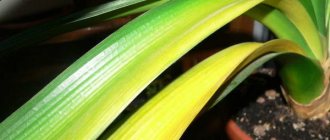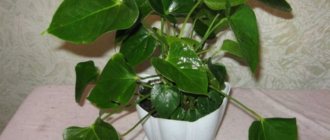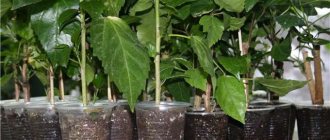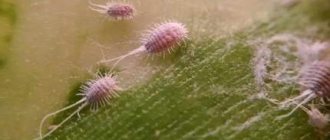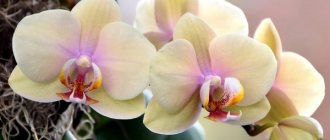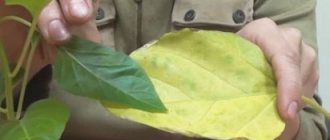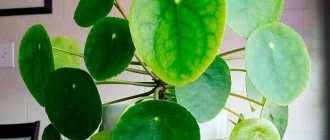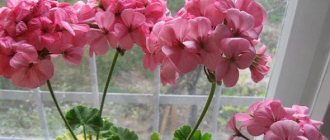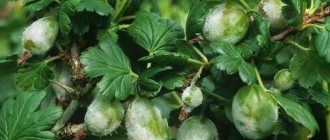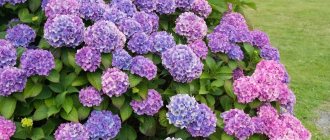Author: Natalya Category: Houseplants Published: February 06, 2019Republished: February 07, 2019Last edits: November 09, 2020
Indoor flowers grow in every home. They not only serve as a source of oxygen, but are also a significant decorative element. However, among houseplants there are also those that confuse superstitious housewives, because, according to legend, they are husband-killers, destroying family well-being and dooming women to loneliness. It is believed that such plants lead to the departure, and sometimes even death, of a beloved man.
Ivy evergreen
This plant is a climbing vine with sinewy leaves of a deep green color. Ivy is easy to care for and grows quite quickly. The stem has thin shoots with which the plant can grow vertically.
There is a folk superstition associated with evergreen ivy - the more luxuriant it grows, the faster the marriage breaks up. In addition, foliage that is too dark poses a danger to love, romantic and family relationships.
Reproduction methods
Ways to get a new plant come down to using apical cuttings or dividing the shoot. Reproduction is usually carried out in the spring, but it can be done at any time of the year. The cuttings are cut under the place where the leaves (nodes) grow and kept in water for several days, then planted in “greasy” soil.
It is advisable to use substances that stimulate the growth of new roots. To increase the chances of rooting, a greenhouse is organized for the baby, covered with glass or a plastic bag. You also need to monitor the lighting: bright and direct rays can destroy the sprout.
Dieffenbachia
An evergreen plant with beautiful, voluminous, ovate green leaves with an unusual yellowish pattern. An adult Dieffenbachia can reach 2 meters in height. This is a rather capricious flower: without increased care, the foliage begins to dry out and then falls off.
Popular belief says that growing Dieffenbachia in the house causes problems with potency in men. In addition, the sap of the plant is poisonous; when evaporated, it causes migraines, and when it comes into contact with the skin, it causes burns. Despite such fame, people like to decorate balcony interiors with Dieffenbachia.
What flowers should not be kept in the house so as not to scare away men: muzhigonny plants
Many single women do not even suspect that the reason for their unsettled personal life may be the indoor plants that they so carefully care for. But husband-growing flowers, leading to the breakup of a family or the death of the breadwinner, do exist. And today we will tell you which plants should not be in the homes of those who dream of a happy marriage.
This plant is also called wax ivy. Its wax flowers and plasticine leaves evoke associations with a cemetery wreath. In addition, hoya is a climbing, climbing and creeping plant, with which many signs and prejudices are associated. Our ancestors believed that wax ivy was capable of killing a man and leaving his wife a widow. It is not worth checking the veracity of this statement from your own experience. Therefore, replace hoya with sansevieria, which is considered a reliable assistant in the struggle for personal happiness.
Oleander
Oleander is a beautiful flower with a pleasant aroma. It is an evergreen shrub with branching stems. The leaves have a narrow lacent shape and are dark green in color. It blooms with beautiful flowers of a pleasant pink color, but there are also white, milky varieties.
The danger of oleander is that all its parts are poisonous. Therefore, they can cause illness in all family members, which negatively affects the home microclimate. You only need to care for it with gloves. If you want to have such a plant, it is better to plant it in a plot in the yard.
Caring for scindapsus at home
The soil
An unpretentious epiprenum will be quite satisfied with universal soil from a hardware store. To prepare the soil yourself, you should mix one part turf, three parts leaf soil, one part sand and add a spoonful of peat.
Lighting
The tropical perennial tolerates a lack of light well, so a place in the back of the room is suitable for it. It is not necessary to use additional lighting. Liana does not like extremes: when caring, both direct sunlight and significant shade should be avoided. Such “extreme” conditions will lead to the fact that authentic diversity will disappear.
Temperature
Like any inhabitant of the jungle, this flower is completely unsuited to cold weather. Therefore, drafts, temperature changes and serious air cooling (below +16°C) should not be allowed. The optimal thermal regime is created at +18…+20°C.
Watering and spraying
Water regularly when the top layer of soil in the pot dries out. In summer - once every two days, in winter - a little less often. Moderation must be observed, since excessive moisture will lead to rotting of the roots. It is better to pre-settle the water; it is also possible to use melted snow.
Hot and dry air is detrimental to scindapsus, so it is better to choose a place away from heating devices.
For the same reason, the flower needs frequent spraying. Small plants can be given a warm shower. Good home care and water treatments will help plants breathe easier and protect them from infection by certain pests.
Pruning, crown formation
Even in an apartment, vines grow at a high speed and require regular pruning and pinching. The first allows you to reduce the length of the stem, and the second allows you to give the desired shape and volume. The right time to do this is before the growth phase begins, that is, in the spring.
Transfer
Once every four years, the scindapsus grows old and sheds its leaves. Therefore, it is recommended to replace it with a young specimen grown from a cutting. Small plants are replanted once a year, replacing the pot with a larger one. Adults “touch” it when necessary, since the stem is easily damaged.
Feeding
Vitamins are added to the soil taking into account the season. In warm weather, feeding is required once every 10-15 days, and in autumn and winter, when the epipremnum stops growing, once every three to four weeks is enough. Preference is given to mineral fertilizers developed for decorative deciduous crops. It must be remembered that these substances should be added after watering. Otherwise, the roots will get burned.
Adenium
A very beautiful plant with a massive, plump stem that resembles a tree trunk. There are a few leaves at the tops, but a feature of adenium is the large number of flowers. Depending on the variety, they can be red, pink, purple, white.
Adenium is a poisonous plant species. Its juice is very poisonous, and the smell is toxic - it can cause severe headaches. In close contact with the plant, the housewife runs the risk of getting a severe burn, so in a house where there are children, it is better to avoid such a flower.
Reed
Some people like the look of coastal cattails in a floor vase. At the same time, they forget that in nature reeds grow in river water in which frogs are found. Our ancestors believed that this plant attracts melancholy, sadness, quarrels and early old age. Of course, this has nothing to do with reality. But do not forget that drying velvety cylinders of reeds release fluff, which provokes allergies. Therefore, it is better to replace it with blooming violets, which protect well-being.
Croton
The plant belongs to the Euphorbiaceae family, although in appearance it resembles a small tree with bright, elongated leaves. At home, croton blooms extremely rarely, and the flowers are not particularly beautiful.
Croton juice is a poisonous substance that can cause burns on the body. If for any reason this juice enters the human blood, this leads to disastrous consequences and resuscitation.
Cissus
Other names for the flower are indoor grape, birch. The most popular among gardeners is the Antarctic cissus, which is native to Australia. Its leaves are serrated-toothed along the edges, have an oval shape and a length of up to 10 cm. The veins are very clearly visible on the leathery surface of the leaf blade. Suitable for vertical gardening or as an hanging plant. It can bloom from spring to late autumn. Cissus shoots have thin tendrils, thanks to which the plant climbs upward.
The flower is very unpretentious and can grow in both good and low light. This muzhegon (flower) develops quite quickly. Its propagation is carried out using layering, placing them directly in the pot with the mother plant.
Hoya
Another name for hoya is waxweed. It is an evergreen climbing plant that can reach 2-3 meters in height. It does not grow synchronously: first a bare stem appears, then rounded leaves with a matte surface appear on it.
Hoya juice can cause a burn on the body, and the smell is very attractive to various insects. Waxwood does not wither for a long time, so wreaths were previously made from it and brought to cemeteries. There is a popular belief that the growth of hoya in the house can soon make a woman a widow.
The whole truth about muzhegons among indoor flowers
Classification of plants accused of "misandry"
There are stories about plants that scare away men. According to legend, all men flee irrevocably from the house where such a flower grows: sons leave their mothers, young girls are abandoned by their grooms, and husbands abandon their wives and children. It seems that the plants deliberately create an atmosphere that is unbearable for the stronger half. Separate flowers primarily include ampelous species with creeping long leaves and shoots: ivy and vines.
Meet the muzhegons
Flora researchers have not identified any mystical effects, that is, the scientific notoriety of muzhegon flowers is not justified. Some of the plants, by absorbing oxygen or emitting harmful fumes, only have a negative effect on the health and well-being of male family members.
Related article: Caring for amaryllis (hippeastrum) after flowering, wintering
However, despite the obvious lack of paranormal properties, people are still afraid to grow the following plants in the house and garden:
Scindapsus, or golden vine, is a plant that attracts with its variegated leaves, but, according to legend, when the phallus-like inflorescences bloom, it takes away sexual power from men. The vine has a long stem, sometimes reaching five meters; the heart-shaped leaves are located singly on it, at a considerable distance from each other. Men do not like this unpretentious flower, but women usually like it.
Cissus: a fragile but lush and beautiful plant, otherwise called indoor grapes. It has dark green leaves sparsely spaced on the stem with embossed edges. They say that cissus, causing irritability and quarrels, contributes to the destruction of relationships and expels representatives of the stronger sex from the house, and the climbing stem of the plant allegedly indicates the ability of cissus to “extract male strength.”
Dieffenbachia: This poisonous indoor flower is primarily a danger to children and pets. It emits harmful fumes that cause headaches. The male part of the family, under the influence of these fumes, may experience a decline in sexual activity, and sometimes even panic attacks. The long-term negative effects of these vapors, according to unverified information, lead to impotence and do not allow the couple to conceive a child.
Young people dreaming of children are advised to get rid of Dieffenbachia as quickly as possible;
Ivy: it is accused that the plant dooms its owner to loneliness, driving the spouse out of the house irrevocably. And the dark color of the leaves supposedly warns of evil forces lurking in them. Ivy has the ability to absorb energy, but no one knows for sure whether it’s good or bad.
Monstera: this representative of the flora is declared not only a muzhegon, but also a vampire: this explains the release of moisture by the plant before the rain. The liquid secreted by the leaves allegedly causes headaches, and therefore it is undesirable to keep this plant in the bedroom, because a man on a subconscious level will strive to leave his home to find a safer place.
Monstera lovers have come up with a way to neutralize the negative properties of this tropical vine: they allow a cat to spend the night in a tub with the plant, which absorbs the harmful vibes of the monstera;
Hoya, or waxweed, or ivy poses such a great danger to the man living in the house that it can leave a woman a widow. Fears arose due to the peculiarity of the plant to remain fresh for a long time, resembling in its appearance plastic flowers in a cemetery. An old proverb warns: “Hoya with flowers is a husband from home feet first.” Bioenergy therapists explain superstition regarding hoya by the negative energy of the plant, which literally hangs in the air. In addition, elongated leaves are poisonous.
Garden "husbands"
Some garden plants are also classified as muzhegons. If you are superstitious, then do not grow on your plot:
Cypress. Despite the fact that the plant has no external resemblance to vines, it is still classified as a muzhegon. According to signs, the flower has bad energy, which negatively affects the stronger sex. In southern countries, cypress is often found in cemeteries - perhaps that is why it is considered the plant of death. Negative energy can provoke nervous stress, breakdown, and prolonged depression, and this applies to both indoor and garden cypress trees.
Rowan: not everyone knows that this beautiful shrub with red berries is planted on the graves of young men who died prematurely. The people dubbed it the “widow’s tree,” but representatives of neighboring countries consider the “widow’s tree” not the rowan, but the viburnum.
Monstera
This plant is a large vine that grows upward. Monstera is easily recognizable due to the unusual shape of its leaves. They are large and have symmetrical threads along the entire area. This is an unpretentious plant that blooms with cobs, the fruits are small berries.
According to signs, monstera absorbs the vital energy of household members and contributes to the husband’s departure from the family. This is due to the fact that after watering, the monstera evaporates moisture, causing migraines. However, it has been noted that the cat is a pet that neutralizes the negative effects of the plant.
Signs for women
- If a plant decorates the house of an unmarried girl with flowers, it means that soon pleasant changes will come into her life, and she will get married.
- Married women should also expect good things to happen if a cactus blooms in their home - signs predict an imminent addition to the family. Moreover, if the flower turns out to be dark, there will be a son, and if the flower turns out to be light, there will be a daughter.
- It is believed that women should not grow cacti in the house. Their flowering means the husband's continuous drunkenness. And the larger the flowering plants, the more serious their influence will be.
Hibiscus or Chinese rose
Hibiscus is a lush shrub that produces flowers of varying textures and shades. The leaves of the plant are also beautiful - they are matte, bright green.
The Chinese rose is considered a muzhegon due to the fact that it requires significant space for its development. Therefore, it is believed that the larger the bush, the faster the husband will leave the family.
When choosing a flower for the home, the appearance and care features, as well as folk signs, are taken into account. Whether or not to take such characteristics into account is the personal choice of each gardener.
- Author: Inna Kiseleva
Rate this article:
- 5
- 4
- 3
- 2
- 1
(12 votes, average: 2.7 out of 5)
Share with your friends!
Why are they called that?
There are many folk superstitions associated with flowers. Some of them bring misfortune and misfortune, while others, on the contrary, create a favorable atmosphere around them. Husband flowers belong to the first type.
Their influence on the male half of humanity is so strong that they simply cannot withstand their negative energy and leave home. Hence the name. And if a woman lives alone, then together with such husband-seekers, you can forget about the appearance of a man.
There are many varieties of muzhegon plants. But there are certain characteristics by which they can be identified. So, for example, if it has long shoots and leaves spreading over the surface, then with a high probability it may turn out to be a muzhegon flower.
There is a conditional division into two categories:
- Obstacles to a happy family life. For example, fern, ficus, liana.
- Forcing a man to leave the house. Ivy, birch, etc.
However, both of these types have a negative impact on personal life and relationships.
Why they are called that is understandable, but where did such beliefs come from? There are many legends that can explain this attitude towards muzhegons. Most of them are associated with a specific plant.
The roots of the most common superstition go back to Ancient Greece. Among the Greeks, ivy was sacred and symbolized the god Dionysus, who, thanks to the flower, remained alive. The mother of Dionysus was Semele, the lover of Hera's husband Zeus. The Earth Goddess could not stand the fact that her husband was looking at another woman and killed Semele. However, her son continued to live. Hera hated Dionysus and everything associated with him, including ivy.
So he began to be personified with troubles, and therefore he was not raised in the house. Cacti have also acquired a bad reputation as a result of a similar story. And if one or two cacti at home will not bring anything bad, then several will definitely not allow an unmarried woman to celebrate her wedding, and will only bring misfortune to a full-fledged family.
The following is a list of names of the 10 most dangerous muzhegons. Not all of them are indoor plants, but even their location in a summer cottage or garden plot can negatively affect the atmosphere in the house.
- Ivy
- Monstera
- Scindapsus
- Cactus
- Dieffenbachia
- Cissus
- Hoya
- Chinese rose
- Rowan
- Cypress
Some of these plants are very popular, and their owners are unaware of their “toxic” effects.
